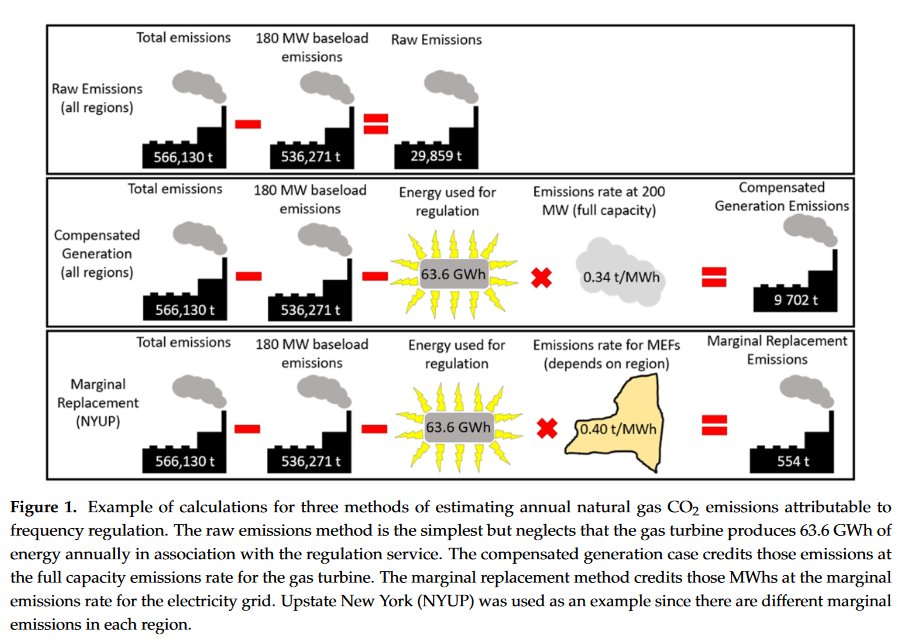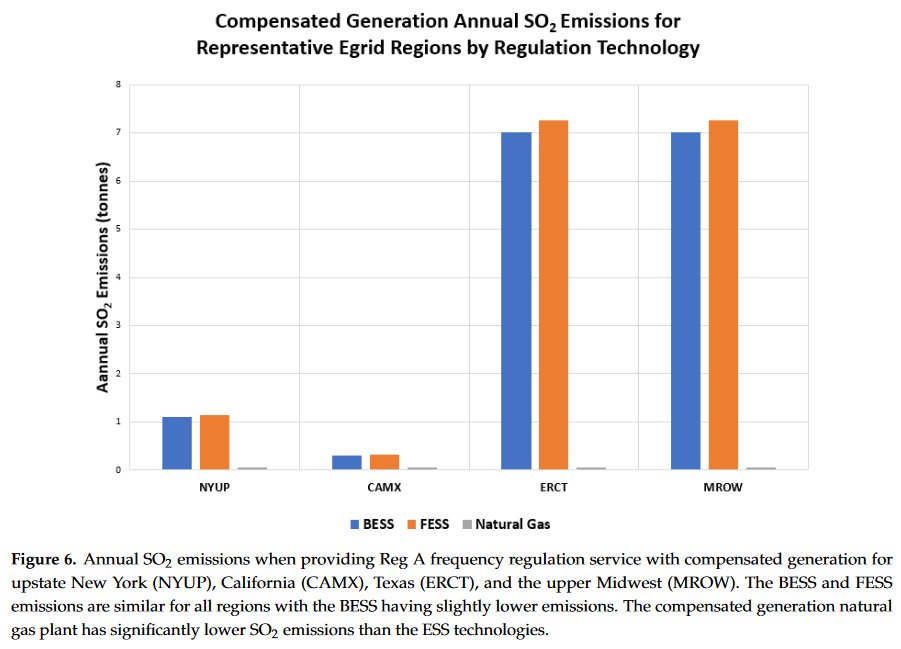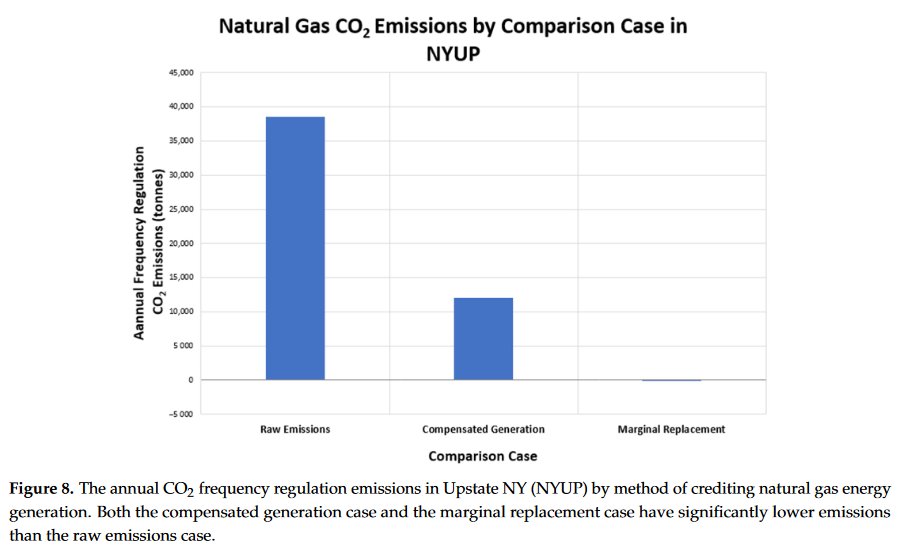New Paper Alert: comparing the emissions effects of doing frequency regulation with storage versus gas turbines (spoiler: storage is better...mostly...probably)
[This one is a bit technical / for specialists, but free to read/download at link below]
https://www.mdpi.com/1996-1073/14/3/549
[This one is a bit technical / for specialists, but free to read/download at link below]
https://www.mdpi.com/1996-1073/14/3/549
First: What is frequency regulation (aka FR or "regulation")?
FR is the thing that balances the grid on a second-to-second basis. Demand is always changing (though usually not a lot) and FR is a service that balances demand and supply, which maintains the system frequency.
FR is the thing that balances the grid on a second-to-second basis. Demand is always changing (though usually not a lot) and FR is a service that balances demand and supply, which maintains the system frequency.
Hypothetically, you could achieve this by having all the generators change their power output a little bit, but that isn't how it is done. Rather, a small set of generators provide this service and ramp up and down to balance the grid.
For logical reasons, the generators that provide FR services tend to be the ones that don't mind ramping up/down. So that is commonly natural gas turbines or hydropower (though other generators provide the service too).
In this paper, we compared storage (battery and flywheel) to a gas turbine (based on the 501FD) providing this service and estimated the emissions from both. Gas turbine emissions are straightforward - they come out the smokestack.
Storage emissions are more complicated -there isn't a smokestack at all. But storage needs energy to do its job because the more you run storage, the more energy is lost. And all that lost energy has to come from the grid. So storage emissions are grid emissions, basically.
A big complication: a gas turbine usually doesn't provide *only* regulations services - it mostly produces energy and leaves some capacity to do FR. So we had to define what the emissions were for the frequency regulation portion of the gas turbine's operation.
Honestly, this might be the most interesting part of the paper: If a 200 MW turbine makes 180 MW of energy and does 20 MW of FR service, that FR service also produces net energy (~10MW on average). How do you "credit" that ~10MW of energy production?
We considered 3 ways to count the emissions from the FR portion:
1. The turbine gets no credit at all for the ~10MW.
2. That ~10MW is credited as if it were produced by the turbine at peak efficiency.
3. That ~10MW is credited as if it were produced by the marginal generator.
1. The turbine gets no credit at all for the ~10MW.
2. That ~10MW is credited as if it were produced by the turbine at peak efficiency.
3. That ~10MW is credited as if it were produced by the marginal generator.
We thought that the 2nd was the most fair (and use that as the base case for results). It essentially says: Net energy produced by the turbine (and not produced by storage) displaces some other energy. That energy is what the turbine would otherwise produce if it wasn't doing FR.
Ok, I'm sure you just want the results by now. Here are CO2 estimates for four representative regions. Our base case estimate is that storage is about half the emissions of the gas turbine, though this depends on a lot of assumptions.
[BESS = battery, FESS = flywheel]
[BESS = battery, FESS = flywheel]
However, for NOx (not shown here) and SO2, a low emissions turbine is much lower. This is basically because a low-emissions gas turbine has much lower NOx and SO2 than marginal generators on existing grids that would provide energy to the storage.
Another point: In the literature, it is often stated (without any real support) that flywheels are a lower-emissions way to provide FR service than batteries. We didn't find that. They seemed basically the same when accounting for both cycling losses and self-discharge.
And another reminder: we had to make a lot of assumptions that are very situation-dependent. The real results depend on properties of the storage and gas turbine, and on what they would be doing otherwise (if they weren't doing FR). Hopefully, we introduced some good ideas.
And the closing point: gas turbines have other limitations for providing FR services: they have to be running (which may not make economic sense). And they aren't actually as good at providing the service as storage. We didn't account for these, but they matter in real life!
I'll give my view here: frequency regulation - fast ramping up and down with limited energy exchange - is exactly the type of thing that storage is good at and thermal generators don't like to do. And it seems like storage can do it with a lower overall emissions effect.

 Read on Twitter
Read on Twitter![New Paper Alert: comparing the emissions effects of doing frequency regulation with storage versus gas turbines (spoiler: storage is better...mostly...probably)[This one is a bit technical / for specialists, but free to read/download at link below] https://www.mdpi.com/1996-1073/14/3/549 New Paper Alert: comparing the emissions effects of doing frequency regulation with storage versus gas turbines (spoiler: storage is better...mostly...probably)[This one is a bit technical / for specialists, but free to read/download at link below] https://www.mdpi.com/1996-1073/14/3/549](https://pbs.twimg.com/media/EsqmUubXUAAKbdw.jpg)

![Ok, I'm sure you just want the results by now. Here are CO2 estimates for four representative regions. Our base case estimate is that storage is about half the emissions of the gas turbine, though this depends on a lot of assumptions.[BESS = battery, FESS = flywheel] Ok, I'm sure you just want the results by now. Here are CO2 estimates for four representative regions. Our base case estimate is that storage is about half the emissions of the gas turbine, though this depends on a lot of assumptions.[BESS = battery, FESS = flywheel]](https://pbs.twimg.com/media/Esqr5QkXAAEnW2O.jpg)





